经济学原理 谭春枝第6章 课后习题答案)
- 格式:doc
- 大小:22.50 KB
- 文档页数:1
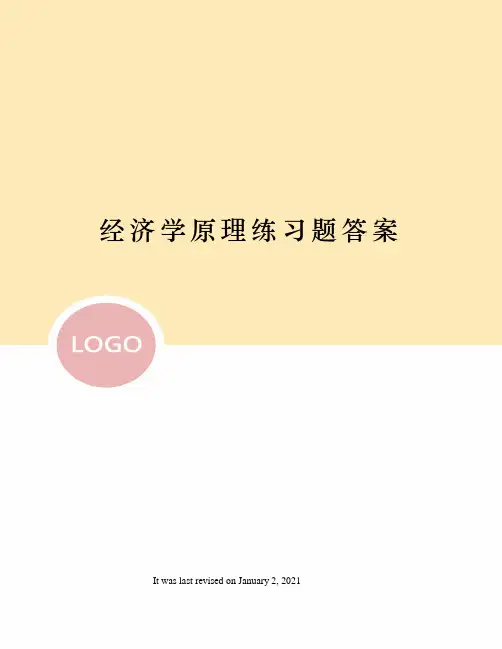
经济学原理练习题答案 It was last revised on January 2, 2021《经济学原理》总目录第一篇导论第二篇微观经济理论第三篇宏观经济理论第一章导论一、单项选择1、作为经济学的两个组成部分,微观经济学与宏观经济学是()A.互相对立的 B.没有任何联系的 C.相互补充的 D.部分联系的2、古典经济学家亚当·斯密所谓的“看不见的手”是指()A.技术 B.信息 C.价格 D.行政命令3、经济学研究的基本问题是()A.生产什么 B.如何生产 C.为谁生产 D.以上都是4、资源的稀缺性是指()。
A.世界上的资源最终会由于人们生产更多的物品而消耗光B.相对于人们无穷的欲望而言,资源总是不足的C.生产某种物品所需资源的绝对数量很少D.由于存在资源浪费而产生的稀缺5、微观经济学解决的问题是()。
A.资源配置 B.资源利用 C.市场出清 D.完全理性6、宏观经济学的中心理论是()。
A.失业理论 B.通货膨胀理论C.国民收入决定理论 D.经济增长理论7、关于实证经济学与规范经济学说法正确的是()A.两者并不是绝对相互排斥的,而应当是相互补充的。
B.规范经济学是以实证经济学为基础,而实证经济学则是以规范经济学作为指导的。
C.一般来说,越是具体的问题,实证的成分越多,而越是高层次的、决策性的问题,就越具有规范性。
D.以上说法都对二、多项选择1、微观经济学的主要内容包括()A.体格决定理论 B.消费者行为理论C.生产者行为理论 D.市场理论和分配理论等2、宏观经济学的基本内容有()A.宏观经济政策 B.经济周期与增长理论C.国民收入决定理论 D.失业与通货膨胀理论3、下列关于资源稀缺性的正确的说法有()A.资源稀缺性是相对于欲望的无限性而言的B.地球上的资源本来就少C.资源稀缺性存在于世界各地D.资源稀缺性存在于人类历史的各个时期三、判断题1、资源的稀缺性决定了资源可以得到充分的利用,不会出现资源浪费的现象。

第4篇公共部门经济学第10章外部性10.1 复习笔记跨考网独家整理最全经济学考研真题,经济学考研课后习题解析资料库,您可以在这里查阅历年经济学考研真题,经济学考研课后习题,经济学考研参考书等内容,更有跨考考研历年辅导的经济学学哥学姐的经济学考研经验,从前辈中获得的经验对初学者来说是宝贵的财富,这或许能帮你少走弯路,躲开一些陷阱。
以下内容为跨考网独家整理,如您还需更多考研资料,可选择经济学一对一在线咨询进行咨询。
1.外部性的含义外部性是指一个经济主体的行为对其他人产生了影响,但并不为此承担相应成本或获得相应收益。
外部性分为正的外部性和负的外部性。
正的外部性是指经济主体的行为对其他人产生了好的影响,但并没有获得相应收益;负的外部性是指经济主体的行为对其他人产生了不好的影响,但并没有为此承担相应成本。
2.外部性与经济效率外部性的影响会造成私人成本和社会成本,或私人收益与社会收益之间的不一致,因此容易造成市场失灵,使市场无效率。
负外部性使生产的社会成本大于私人成本,所以社会供给曲线位于市场供给曲线之上,市场生产的数量大于社会合意的数量,该产品的生产出现过剩。
正外部性使生产的社会收益大于私人收益,所以社会价值曲线位于市场需求曲线之上,市场生产的数量小于社会合意的数量,该产品的生产出现短缺。
3.解决外部性的方法(1)科斯定理科斯定理是揭示市场经济中产权安排、交易成本和资源配置效率之间关系的原理。
其内容是:在交易费用为零时,只要产权初始界定清晰,并允许经济当事人进行谈判交易,就可以导致资源的有效配置。
科斯定理在于说明,只要假设条件成立,市场势力就足够大,从而外部性问题总能通过市场自身来解决,而不需要政府的干预。
(2)私人解决外部性的方法①用道德规范和社会约束来解决;②慈善行为;③通过依靠有关各方的私利来解决外部性问题;④利益各方签订合约。
私人经济主体可能通过以上方式解决外部性问题,但在现实中,由于一些限制性因素,使得私人主体并不能很好地解决外部性引起的问题。
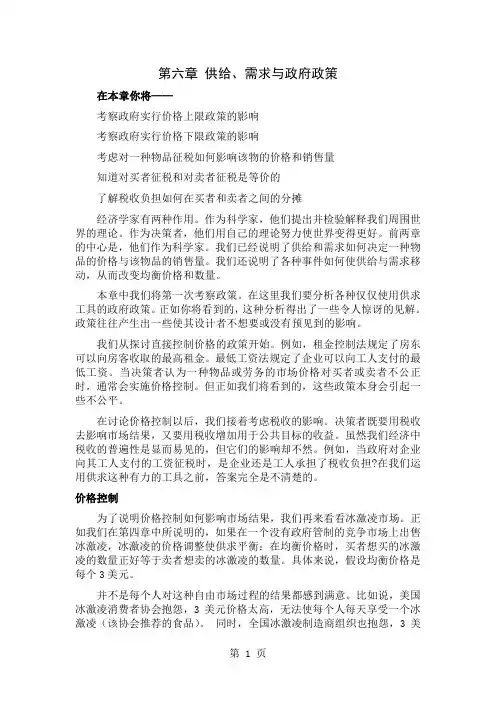
第六章供给、需求与政府政策在本章你将——考察政府实行价格上限政策的影响考察政府实行价格下限政策的影响考虑对一种物品征税如何影响该物的价格和销售量知道对买者征税和对卖者征税是等价的了解税收负担如何在买者和卖者之间的分摊经济学家有两种作用。
作为科学家,他们提出并检验解释我们周围世界的理论。
作为决策者,他们用自己的理论努力使世界变得更好。
前两章的中心是,他们作为科学家。
我们已经说明了供给和需求如何决定一种物品的价格与该物品的销售量。
我们还说明了各种事件如何使供给与需求移动,从而改变均衡价格和数量。
本章中我们将第一次考察政策。
在这里我们要分析各种仅仅使用供求工具的政府政策。
正如你将看到的,这种分析得出了一些令人惊讶的见解。
政策往往产生出一些使其设计者不想要或没有预见到的影响。
我们从探讨直接控制价格的政策开始。
例如,租金控制法规定了房东可以向房客收取的最高租金。
最低工资法规定了企业可以向工人支付的最低工资。
当决策者认为一种物品或劳务的市场价格对买者或卖者不公正时,通常会实施价格控制。
但正如我们将看到的,这些政策本身会引起一些不公平。
在讨论价格控制以后,我们接着考虑税收的影响。
决策者既要用税收去影响市场结果,又要用税收增加用于公共目标的收益。
虽然我们经济中税收的普遍性是显而易见的,但它们的影响却不然。
例如,当政府对企业向其工人支付的工资征税时,是企业还是工人承担了税收负担?在我们运用供求这种有力的工具之前,答案完全是不清楚的。
价格控制为了说明价格控制如何影响市场结果,我们再来看看冰激凌市场。
正如我们在第四章中所说明的,如果在一个没有政府管制的竞争市场上出售冰激凌,冰激凌的价格调整使供求平衡:在均衡价格时,买者想买的冰激凌的数量正好等于卖者想卖的冰激凌的数量。
具体来说,假设均衡价格是每个3美元。
并不是每个人对这种自由市场过程的结果都感到满意。
比如说,美国冰激凌消费者协会抱怨,3美元价格太高,无法使每个人每天享受一个冰激凌(该协会推荐的食品)。
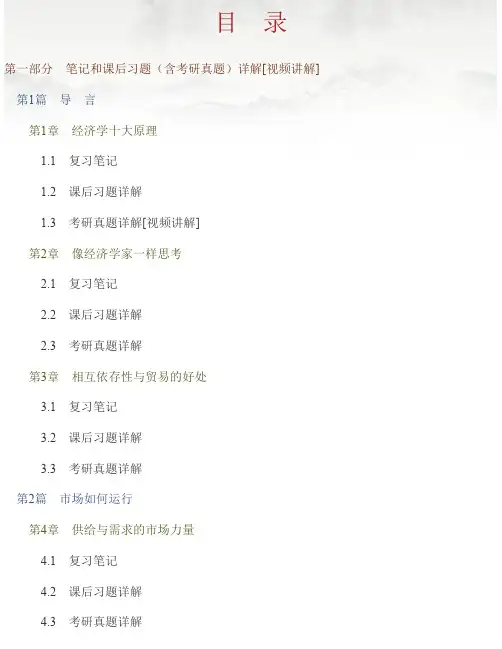
目 录第一部分 笔记和课后习题(含考研真题)详解[视频讲解]第1篇 导 言第1章 经济学十大原理1.1 复习笔记1.2 课后习题详解1.3 考研真题详解[视频讲解]第2章 像经济学家一样思考2.1 复习笔记2.2 课后习题详解2.3 考研真题详解第3章 相互依存性与贸易的好处3.1 复习笔记3.2 课后习题详解3.3 考研真题详解第2篇 市场如何运行第4章 供给与需求的市场力量4.1 复习笔记4.2 课后习题详解4.3 考研真题详解第5章 弹性及其应用5.1 复习笔记5.2 课后习题详解5.3 考研真题详解[视频讲解]第6章 供给、需求与政府政策6.1 复习笔记6.2 课后习题详解6.3 考研真题详解[视频讲解]第3篇 市场和福利第7章 消费者、生产者与市场效率7.1 复习笔记7.2 课后习题详解7.3 考研真题详解第8章 应用:赋税的代价8.1 复习笔记8.2 课后习题详解8.3 考研真题详解第9章 应用:国际贸易9.1 复习笔记9.2 课后习题详解9.3 考研真题详解第4篇 公共部门经济学第10章 外部性10.1 复习笔记10.2 课后习题详解10.3 考研真题详解[视频讲解]第11章 公共物品和公共资源11.1 复习笔记11.2 课后习题详解11.3 考研真题详解[视频讲解]第12章 税制的设计12.1 复习笔记12.2 课后习题详解12.3 考研真题详解第5篇 企业行为与产业组织第13章 生产成本13.1 复习笔记13.2 课后习题详解13.3 考研真题详解[视频讲解]第14章 竞争市场上的企业14.1 复习笔记14.2 课后习题详解14.3 考研真题详解[视频讲解]第15章 垄 断15.1 复习笔记15.2 课后习题详解15.3 考研真题详解[视频讲解]第16章 垄断竞争16.1 复习笔记16.2 课后习题详解16.3 考研真题详解[视频讲解]第17章 寡 头17.1 复习笔记17.2 课后习题详解17.3 考研真题详解[视频讲解]第6篇 劳动市场经济学第18章 生产要素市场18.1 复习笔记18.2 课后习题详解18.3 考研真题详解[视频讲解]第19章 收入与歧视19.1 复习笔记19.2 课后习题详解19.3 考研真题详解第20章 收入不平等与贫困20.1 复习笔记20.2 课后习题详解20.3 考研真题详解[视频讲解]第7篇 深入研究的论题第21章 消费者选择理论21.1 复习笔记21.2 课后习题详解21.3 考研真题详解[视频讲解]第22章 微观经济学前沿22.1 复习笔记22.2 课后习题详解22.3 考研真题详解[视频讲解]第二部分 模拟试题及详解曼昆《经济学原理(微观经济学分册)》(第6版)模拟试题及详解(一)曼昆《经济学原理(微观经济学分册)》(第6版)模拟试题及详解(二)第一部分 笔记和课后习题(含考研真题)详解[视频讲解]第1篇 导 言第1章 经济学十大原理1.1 复习笔记1.经济学经济学是研究如何将稀缺的资源有效地配置给相互竞争的用途,以使人类的欲望得到最大限度满足的科学。
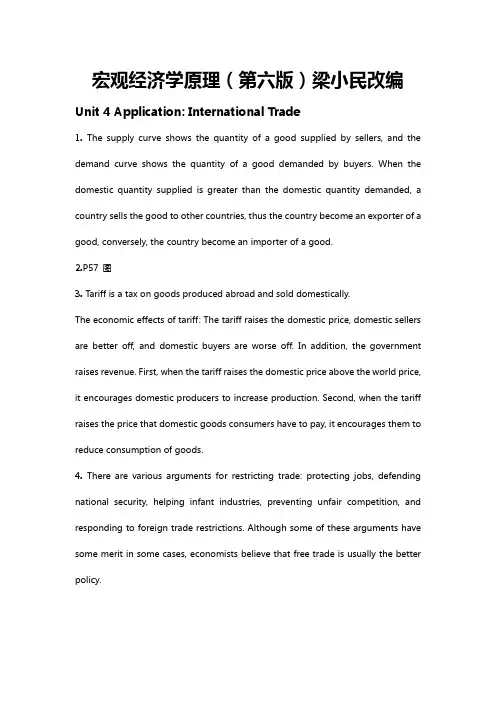
宏观经济学原理(第六版)梁小民改编Unit 4 Application: International Trade1.The supply curve shows the quantity of a good supplied by sellers, and the demand curve shows the quantity of a good demanded by buyers. When the domestic quantity supplied is greater than the domestic quantity demanded, a country sells the good to other countries, thus the country become an exporter of a good, conversely, the country become an importer of a good.2.P57 图3. Tariff is a tax on goods produced abroad and sold domestically.The economic effects of tariff: The tariff raises the domestic price, domestic sellers are better off, and domestic buyers are worse off. In addition, the government raises revenue. First, when the tariff raises the domestic price above the world price, it encourages domestic producers to increase production. Second, when the tariff raises the price that domestic goods consumers have to pay, it encourages them to reduce consumption of goods.4. There are various arguments for restricting trade: protecting jobs, defending national security, helping infant industries, preventing unfair competition, and responding to foreign trade restrictions. Although some of these arguments have some merit in some cases, economists believe that free trade is usually the better policy.Unit 5 Measuring a Nations Income1. The production of a luxury car contributes more to GDP than the production of an economy car. Because market prices measure the amount people are willing to pay for different goods, they reflect the value of those goods. The luxury car has a higher market value.2. The contribution to GDP is 3$, the market value of the bread, which is the final good that is sold.3. The four components of GDP are consumption, such as the purchase of a music CD; investment, such as the purchase of a computer by a business; government purchases, such as an order for military aircraft; and net exports, such as the sale of American wheat to Russian.4.Economists use real GDP rather than nominal GDP to gauge economic well- being because real GDP is not affected by changes in prices, so it reflects only changes in the amounts being produced. If nominal GDP rises, you do not know if that is because of increased production or higher prices.Unit 6 Measuring the Cost of Living1. A 10 percent increase in the price of chicken has a greater effect on the consumer price index than a 10 percent increase in the price of caviar because chicken is a bigger part of the average consumer’s market basket.2. The three problems in the consumer price index as a measure of the cost of living are: (1) substitution bias, which arises because people substitute toward goods thathave become relatively less expensive; (2) the introduction of new goods, which are not reflected quickly in the CPI; (3)unmeasured quality change3. If the price of a Navy submarine rises, there is no effect on the consumer price index, since Navy submarines are not consumer goods. But the GDP price index is affected, since Navy submarines are included in GDP as a part of government purchases.4. Since the overall price level doubled, but the price of the candy bar rose sixfold, the real price (the price adjusted for inflation) of the candy bar tripled.5. The nominal interest rate is the interest rate paid on a loan in dollar terms.The real interest rate is the interest rate corrected for the effects of inflation.The real interest rate is the nominal interest rate minus the rate of inflation.Unit 7 Production and Growth1. The four determinants of productivity are: (1) physical capital, which is the stock of equipment and structures that are used to produce goods and services; (2) human capital, which consists of the knowledge and skills that workers acquire through education, training, and experience;(3)natural resources, which are inputs into the production of goods and services that are provided by nature; and (4)technological knowledge, which is society’s understanding of the best ways to produce goods and services.2. Higher saving means fewer resources are devoted to consumption and more to producing capital goods. The rise in the capital stock leads to rising productivityand more rapid growth in GDP for a while. In the long run, the higher saving rate leads to a higher standard of living. A policymaker might be deterred from trying to raise the rate of saving because doing so requires that people reduce their consumption today and it can take a long time to get a higher standard of living.3. Removing a trade restriction, such as a tariff, would lead to more rapid economic growth because the removal of the trade restriction acts like an improvement in technology. Free trade allows all countries to consume more goods and services.4.The higher the rate of population growth, the lower is the level of GDP per person, because there’s less capital per person, hence lower productivity.5. The U.S government tries to encourage advances in technological knowledge by providing research grants through the National Science Foundation and the National Institute of Health, with tax breaks for firms engaging in research and development, and through the patent system.Unit 8 Saving, Investment, and the Financial System1. It is important for people who own stocks and bonds to diversify their holdings because then they will have only small stake in each asset, which reduces risk. Mutual funds make such diversification easy by allowing a small investor to purchase parts of hundreds of different stocks and bonds.2.National saving is the amount of a nation’s income that is not spent on consumption or government purchases. Private saving is the amount of income that households have left after paying their taxes and paying for their consumption.Public saving is the amount of tax revenue that the government has left paying for its spending. The three variables are related because national saving equals private saving plus public saving.3. Investment refers to the purchase of new capital, such as equipment or buildings. It is equal to national saving.4. A change in tax code that might increase private saving is the introduction of a consumption tax to replace the income tax. Since a consumption tax would not tax the returns saving, it would increase the supply of loanable funds, thus lowering interest rates and increasing investment.5. A government budget deficit arises when government spends more than it receives in tax revenue. Since a government budget deficit reduces national saving, it raises interest rates, reduces private investment, and thus reduces economic growth.Unit 9 The Basic Tools of Finance1. Purchasing insurance allows an individual to reduce the level of risk he faces. Two problems that impede the insurance industry from working correctly are adverse selection and moral hazard. Adverse selection occurs because a high-risk person is more likely to apply for insurance than a low-risk person is. Moral hazard occurs because people have less incentive to be careful about their risky behavior after they purchase insurance.2. A stock analyst will consider the future profitability of a firm when determiningthe value of the stock.3. The efficient markets hypothesis suggests that stock prices reflect all avaiable information. This means that we cannot use current information to predict future changes in stock prices. One piece of evidence that supports this theory is the fact that many index funds out perform mutual funds that are actively managed by a professional portfolio manager.Unit 10 Unemployment1.(1)Frictional unemplotment is inevtiable because the economy is always changing. Some firms are shringking while others are expanding. Some regions are experiencing faster growth than other regions. Transitions of workers between firms and between regions are accompanied by temporary unemployment.(2)The government could help to reduce the amount of fritional unemployment by public policies that provide information about job vacancies in order to match workers and jobs more quickly, and through public training programs that help ease the transition of workers from declining to expanding industries and help disadvantaged groups escape poverty.2.Minimum-wage laws are a better explanation for unemployment among teenagers than among college graduates. Teenagers have fewer job-related skills than college graduates do, so their wages are low enough to be affected by the minimum wage. College graduates’wages generally exceed the minimum wage.3.Unions may affect the natural rate of unemployment via the effect on insidersand outsiders. Since unions raise the wage above the equilibrium level, the quantity of labor demanded declines while the quantity supplied of labor rises, so there is unemployment. Insiders are those who keep their jobs. Outsiders, workers who become unemployed, have two choices: either get a job in a firm that is not unionized or remain unemployed and wait for a job to open up in the uion sector. As a result, the natural rate of unemployment is higher than it would be without unions.4.Advocates of unions claim that unions are good for the economy because they are an antidote to the market power of the firms that hire workers and they are important for helping firms respond effeiciently to workers’ concerns.5. Four reasons why a firm’s profits might increase when it raises wages are: (1) better paid workers are healthier and more productive; (2) worker turnover is reduced; (3)worker effort is increased; and (4) the firm can attract higher quality workers.Unit 11 The Monetary System1. Money is different from other assets in the economy because it is most liquid asset available. Other assets vary widely in their liquidity.2. Commodity money is money with intrinsic value, like gold, which can be used for purposes other than as a medium of exchange. Fiat money without intrinsic value, it has no value other than its use as a medium of exchange. Our economy today uses fiat money.3. If the fed wants to increase the supply of money with open-market operation, it purchases U.S government bonds from the public on the open market. The purchase increases the number of dollars in the hand of the public, thus raising the money supply.4. Reserve requirements are regulations on the minimum amount of reserves that banks must hold against deposits. An increase in reserve requirement raises the ratio, lowers the money multiplier, and decreases the money supply.5.The discount rate is the interest rate loans that the Federal Reserve makes to banks. If the Fed raises the discount rate, fewer banks will borrow from the Fed, so banks’ reserves will be lower, and thus the money supply will be lower.6. The Fed cannot control the money supply perfectly because: (1) the Fed does not control the amount of money that households choose to hold as deposits in banks, and (2) the Fed does not control the amount that bankers choose to lend. The actions of households and banks affect the money supply in ways the Fed cannot perfectly control or predict.Unit 12 Money Growth and Inflation1.According to the quantity theory of money, an increase in the quantity of money causes a proportional increase in the price level.2. Nominal variables are those measured in monetary units, while real variables are those measured in physical units. Examples of nominal variables include the prices of goods, wages, and the dollar value of GDP. Examples of real variablesinclude relative prices (the price of one good in terms of anthor), real wages, and real GDP. According to the pricinple of monetary neutrality, only nominal variables are affected by changes in the quantity of money.3.Inflation is like a tax because everyone who holds money loses purchasing power. In a hyperinflation, the government increases the money supply rapidly, which leads to a high rate of inflation. Thus the government uses the inflation tax, instead of taxes on income, to finace its spending.4.According to the Fisher effect, an increase in the inflation rate raises the nominal interest rate by the same amount that the inflation rate increases, with no effect on the real interest rate.5. If inflation is less than expected, creditors benefit and debtors lose. Creditors receive dollar payments from debtors that have a higher real value than was expected.Unit 13 Open-Economy Macroeconomics Basic Concepts 1.The net exporys of a country are the value of its exports minus the value of its imports.Net capital outflow refers to the purchase of foreign assets by domestic residents minus the purchase of domestic assets by foreigners.Net exports are equal to net capital outflow by an accounting identity, since exports from one country to anthor are matched by payments of some asset from the second country to the first.2.Saving equals domestic investment plus net capital outflow, since any dollar saved can be used to finace accumulation of domestic capital or it can be used to fiance the purchase of capital abroad.3.If a dollar can buy 100 yen, the nominal exchange rate is 100 yen per dollar. The real exchange rate equals the nominal exchange rate times the domestic price divided by the foreign price, which equals 100 yen per dollar times $10,000 per Ameican car divided by 500,000 yen per Japanese car, which equals 2 Japanese cars per Ameican car.4.The economic logic behindd the theory of purchasing-power parity is that a good must sell for the same price in all locations. Otherwise, people would profit by engaing in arbitrage.5. If the Fed started printing large quantities of U.S. dollars, the U.S price level would increase, and a dollar would buy fewer Japanese yen.Unit 14 A Macroeconomic Theory of the Open Economy 1.The supply of loanable funds comes from natinal saving, the demand for loanable funds comes from domestic investment and net capital outflow. The supply of doallars in the market for foreign exchange comes from net capital outflow, the demand for dollars in the market for foreign exchange comes from net ecperts. The line between the two martkets is net capital outflow.ernment budget deficits and trade deficits are sometimes called the twin deficits because a governmemt budget deficit often leads to trade deficit. Thedovernment budget deficit leads to reduced national saving, causing the interest rate increase, thus reducing net capital outflow, which in reduces net exports.3.If a union of textile workers encourages people tp buy only Aerican-made clothes, imports would be reduced, so net exports would increase for any given real exchange rate. This would cause the demand curve in the market for foreign exchange to shift to the right, as shown in Figure 2. The result is rise in the real exchange rate, but no effct on the trade balance. The textile industry would import less, but other industries, such as the auto industry. Would import more because of the higher real exchange rate.4. Capital flight is a large and sudden movement of funds out of a country. Capital flight cause the interest rate to increase and the exchange rate to depreciate.Unit 15 Aggregate Demand and Aggregate Supply1.Three aggregate-demand curve is downward sloping because: (1) a decrease in the price level makes consumers feel wealthier, which in turn encourages them to spend more, so there is a larger quantity of goods and services demanded; (2) a lower price level reduces the interest rate, enouraging greater spending on investment, so there is a larger quantity of goods and services demanded; (3) a fall in the U.S. price level causes U.S. interest rates to fall, so the real exchange rate depreciates, stimulating U.S. net exports, so there is a larger quantity of goods and services demande.2.The long-run aggregate supply curve is vertical because in the long run, an economy’s supply of goods and services depends on its supplies of capital, labor, and natural resources and on the available production technology used to turn these resources into goods and services. The price level does not affect these long-run dererminants of real GDP.3. The aggregated-demand curve might shift to the left when something (other than a rise in the price level )causes a reduction in consumption spending(such as a desire for increased saving), a reduction in investment spending(such as increased taxes on the returns to investment), decreased government spending(such as a cutback in defense spending), or reduced net exports(such as when foreign economics go into recession, so our exports fall.)Figure 4 traces through the steps of such a shift in aggregate demand. The economy begins in equilibrium, with short-run aggregate supply, AS1, intersectingaggregate demand, AD1 , at point A. When the aggregate-demand curve shifts to the left to AD2 , the economy moves from point A to point B, reducing the price level and the quantity of output. Over time, people adjust their perceptions, wages, and prices, shifting the short-run aggregate-supply curve down to AS2 , and moving the economy from point B to point C, which is back on the long-run aggregate supply curve and has a lower price level.4. The aggregate-supply curve might shift to the left because of a decline in the economy’s capital stock, labor supply, or productivity, or an increase in the natural rate of unemployment, all of which shift both the long-run and short-run aggregate supply curves to the left. An increase in the expected price level shifts just the short-run aggregate-supply curve(not the long-run aggregate-supply curve)to the left.Figures 5 traces through the effects of such a shift. The economy starts in equilibrium at point A. The aggregate-supply curve then shifts to the left from AS1 to AS2. The new equilibrium is at point B, the intersection of aggregate-demand curve and AS2. As time goes on; the economy returns to long-run equilibrium at point A, as the short-run aggregate supply curve shifts back to its original position.Unit 16 The Influence of Monetary and Fiscal Policy on Aggregate Demand1.The theory of liquidity preference is Keynes’s theory of how the interst rate is determined. According to the thoery, the aggregate-demand curve slopes downward because: (1) a higher price level raises money demand; (2) higher money demand leads to higher interest rate; and (3) a higher interest rate reduces the quantity of goods and services demanded. Thus the price level has a negative relationship with the quantity of goods and services demanded.2. A decrease in the money supply shifts the money-supply curve to the left. The money-supply curve now intersects the money-demand curve at a higher interest rate. The higher interest rate reduces consumption and investment, so aggregate dmand falls. Thus, the aggregate-demand curve shifts to the left.3.If the government spends $3 billion to buy police cars, aggregate demand might increase by more than $3 billion because of the mutiple effect on aggregate demand. Aggregate demand might increase by less than $3 billion because of the crowding-out effect on aggregate demand.4. If pessimism sweeps the country, households reduce consumption spending and firms reduce investment, so aggregate demand falls. If the Fed wants to stabilize aggregate demand, it must increase the money supply, reducing the interest rate, which will include households to save less and spend more and will encourage firms to invest more, both of which will increase aggregate demand. If the Fed does not increase the money supply, Congress could increase government purchases or reduce taxes to increase aggregate demand.ernment policies that act as automatic stabilizers include the tax system and government spending through the unemployment-benefit system. The tax system acts as an automatic stabilizer because when incomes are high , people pay more in taxes, so they cannot spend as much. When incomes are low, so are taxes; thus people can spend more. The result is that spending is partly stabilized. Government spending through the unemployment-benefit system acts as an automatic stabilizer because in recessions the government transfers money to theunemployed so their incomes do not fall as much and thus their spending will not fall as much.。
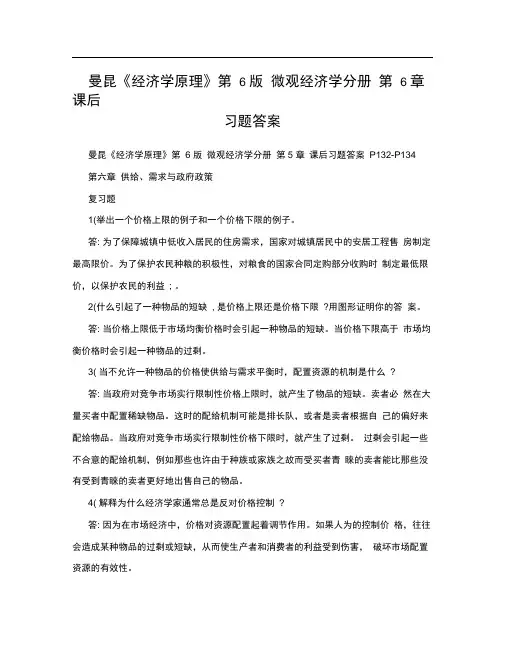
曼昆《经济学原理》第 6 版微观经济学分册第 6 章课后习题答案曼昆《经济学原理》第 6 版微观经济学分册第5 章课后习题答案P132-P134第六章供给、需求与政府政策复习题1(举出一个价格上限的例子和一个价格下限的例子。
答: 为了保障城镇中低收入居民的住房需求,国家对城镇居民中的安居工程售房制定最高限价。
为了保护农民种粮的积极性,对粮食的国家合同定购部分收购时制定最低限价,以保护农民的利益; 。
2(什么引起了一种物品的短缺, 是价格上限还是价格下限?用图形证明你的答案。
答: 当价格上限低于市场均衡价格时会引起一种物品的短缺。
当价格下限高于市场均衡价格时会引起一种物品的过剩。
3( 当不允许一种物品的价格使供给与需求平衡时,配置资源的机制是什么?答: 当政府对竞争市场实行限制性价格上限时,就产生了物品的短缺。
卖者必然在大量买者中配置稀缺物品。
这时的配给机制可能是排长队,或者是卖者根据自己的偏好来配给物品。
当政府对竞争市场实行限制性价格下限时,就产生了过剩。
过剩会引起一些不合意的配给机制,例如那些也许由于种族或家族之故而受买者青睐的卖者能比那些没有受到青睐的卖者更好地出售自己的物品。
4( 解释为什么经济学家通常总是反对价格控制?答: 因为在市场经济中,价格对资源配置起着调节作用。
如果人为的控制价格,往往会造成某种物品的过剩或短缺,从而使生产者和消费者的利益受到伤害,破坏市场配置资源的有效性。
5( 假设政府取消向一种物品的买者征税,而向这种物品的卖者征同样的税。
税收政策的这种变动如何影响买者为这种物品向卖者支付的价格、买者所支付的包括税在内的货币量、卖者扣除税收得到的货币量以及销售量,答: 税收政策的变动对它们都不产生影响。
因为税收的归宿取决于供给和需求的价格弹性,而不取决于向买者征税还是向卖者征税。
6( 一种物品的税收如何影响买者支付的价格、卖者得到的价格,以及销售量答:一种物品的税收使买者支付的价格上升,卖者得到的价格下降,销售量下降。
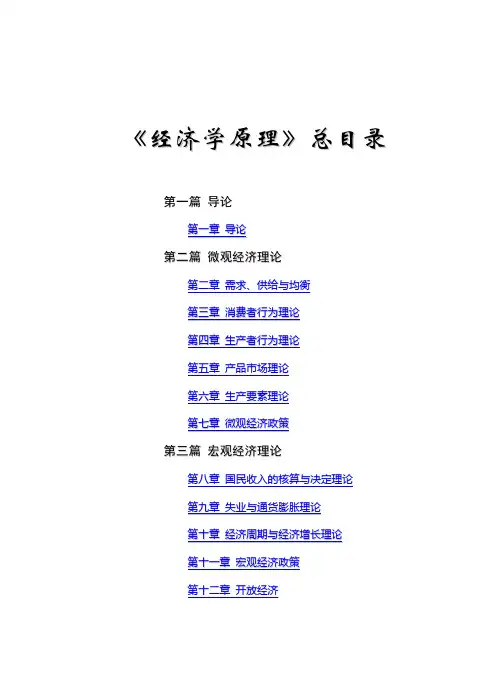
《经济学原理》总目录第一篇导论第一章导论第二篇微观经济理论第二章需求、供给与均衡第三章消费者行为理论第四章生产者行为理论第五章产品市场理论第六章生产要素理论第七章微观经济政策第三篇宏观经济理论第八章国民收入的核算与决定理论第九章失业与通货膨胀理论第十章经济周期与经济增长理论第十一章宏观经济政策第十二章开放经济第一章导论一、单项选择1、作为经济学的两个组成部分,微观经济学与宏观经济学是()A.互相对立的B.没有任何联系的C.相互补充的D.部分联系的2、古典经济学家亚当·斯密所谓的“看不见的手”是指()A.技术B.信息C.价格D.行政命令3、经济学研究的基本问题是()A.生产什么B.如何生产C.为谁生产D.以上都是4、资源的稀缺性是指()。
A.世界上的资源最终会由于人们生产更多的物品而消耗光B.相对于人们无穷的欲望而言,资源总是不足的C.生产某种物品所需资源的绝对数量很少D.由于存在资源浪费而产生的稀缺5、微观经济学解决的问题是()。
A.资源配置B.资源利用C.市场出清D.完全理性6、宏观经济学的中心理论是()。
A.失业理论B.通货膨胀理论C.国民收入决定理论D.经济增长理论7、关于实证经济学与规范经济学说法正确的是()A.两者并不是绝对相互排斥的,而应当是相互补充的。
B.规范经济学是以实证经济学为基础,而实证经济学则是以规范经济学作为指导的。
C.一般来说,越是具体的问题,实证的成分越多,而越是高层次的、决策性的问题,就越具有规范性。
D.以上说法都对二、多项选择1、微观经济学的主要内容包括()A.体格决定理论B.消费者行为理论C.生产者行为理论D.市场理论和分配理论等2、宏观经济学的基本内容有()A.宏观经济政策B.经济周期与增长理论C.国民收入决定理论D.失业与通货膨胀理论3、下列关于资源稀缺性的正确的说法有()A.资源稀缺性是相对于欲望的无限性而言的B.地球上的资源本来就少C.资源稀缺性存在于世界各地D.资源稀缺性存在于人类历史的各个时期三、判断题1、资源的稀缺性决定了资源可以得到充分的利用,不会出现资源浪费的现象。
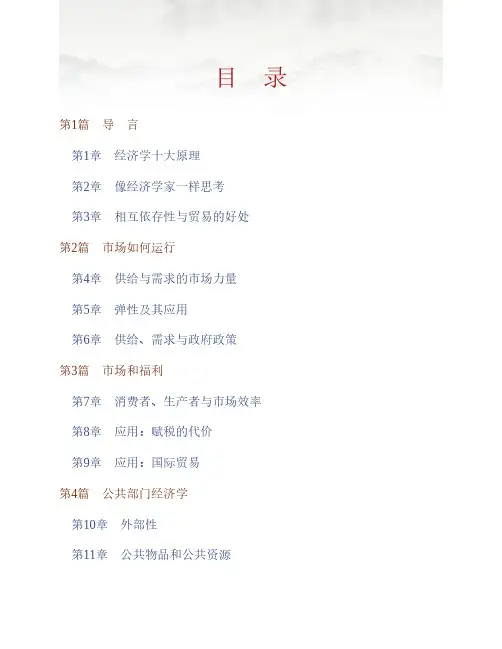
目 录第1篇 导 言第1章 经济学十大原理第2章 像经济学家一样思考第3章 相互依存性与贸易的好处第2篇 市场如何运行第4章 供给与需求的市场力量第5章 弹性及其应用第6章 供给、需求与政府政策第3篇 市场和福利第7章 消费者、生产者与市场效率第8章 应用:赋税的代价第9章 应用:国际贸易第4篇 公共部门经济学第10章 外部性第11章 公共物品和公共资源第12章 税制的设计第5篇 企业行为与产业组织第13章 生产成本第14章 竞争市场上的企业第15章 垄 断第16章 垄断竞争第17章 寡 头第6篇 劳动市场经济学第18章 生产要素市场第19章 收入与歧视第20章 收入不平等与贫困第7篇 深入研究的论题第21章 消费者选择理论第22章 微观经济学前沿第1篇 导 言第1章 经济学十大原理一、概念题1.稀缺性(scarcity)答:经济学研究的问题和经济物品都是以稀缺性为前提的。
稀缺性指在给定的时间内,相对于人的需求而言,经济资源的供给总是不足的,也就是资源的有用性与有限性。
人类消费各种物品的欲望是无限的,满足这种欲望的物品,有的可以不付出任何代价而随意取得,称之为自由物品,如阳光和空气;但绝大多数物品是不能自由取用的,因为世界上的资源(包括物质资源和人力资源)是有限的,这种有限的、为获取它必须付出某种代价的物品,称为“经济物品”。
正因为稀缺性的客观存在,地球上就存在着资源的有限性和人类的欲望与需求的无限性之间的矛盾。
经济学的一个重要研究任务就是:“研究人们如何进行抉择,以便使用稀缺的或有限的生产性资源(土地、劳动、资本品如机器、技术知识)来生产各种商品,并把它们分配给不同的社会成员进行消费。
”也就是从经济学角度来研究使用有限的资源来生产什么、如何生产和为谁生产的问题。
2.经济学(economics)答:经济学是研究如何将稀缺的资源有效地配置给相互竞争的用途,以使人类的欲望得到最大限度满足的科学。
时下经常见诸国内报刊文献的“现代西方经济学”一词,大多也都在这个意义上使用。
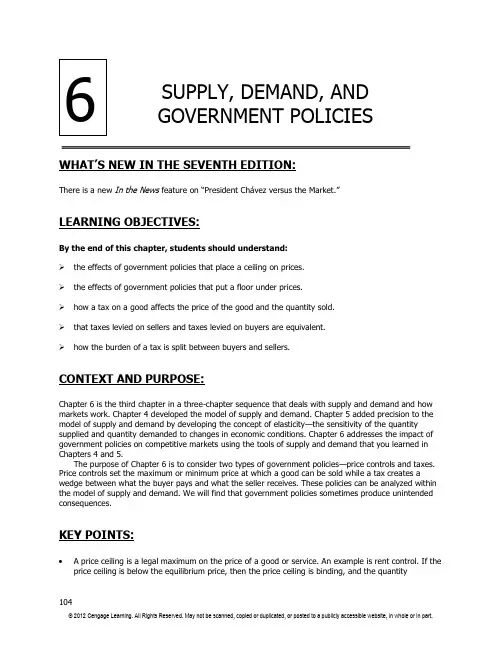
104WHAT’S NEW IN THE S EVENTH EDITION:There is a new In the News feature on “President Chávez versus the Market.”LEARNING OBJECTIVES:By the end of this chapter, students should understand:➢ the effects of government policies that place a ceiling on prices.➢ the effects of government policies that put a floor under prices.➢ how a tax on a good affects the price of the good and the quantity sold.➢ that taxes levied on sellers and taxes levied on buyers are equivalent.➢ how the burden of a tax is split between buyers and sellers.CONTEXT AND PURPOSE:Chapter 6 is the third chapter in a three-chapter sequence that deals with supply and demand and how markets work. Chapter 4 developed the model of supply and demand. Chapter 5 added precision to the model of supply and demand by developing the concept of elasticity —the sensitivity of the quantity supplied and quantity demanded to changes in economic conditions. Chapter 6 addresses the impact of government policies on competitive markets using the tools of supply and demand that you learned in Chapters 4 and 5.The purpose of Chapter 6 is to consider two types of government policies —price controls and taxes. Price controls set the maximum or minimum price at which a good can be sold while a tax creates awedge between what the buyer pays and what the seller receives. These policies can be analyzed within the model of supply and demand. We will find that government policies sometimes produce unintended consequences.KEY POINTS:•A price ceiling is a legal maximum on the price of a good or service. An example is rent control. If the price ceiling is below the equilibrium price, then the price ceiling is binding, and the quantitySUPPLY, DEMAND, AND GOVERNMENT POLICIESChapter 6/Supply, Demand, and Government Policies ❖105demanded exceeds the quantity supplied. Because of the resulting shortage, sellers must in some way ration the good or service among buyers.• A price floor is a legal minimum on the price of a good or service. An example is the minimum wage.If the price floor is above the equilibrium price, then the price floor is binding, and the quantitysupplied exceeds the quantity demanded. Because of the resulting surplus, buyers’ demands for the good or service must in some way be rationed among sellers.• When the government levies a tax on a good, the equilibrium quantity of the good falls. That is, a tax on a market shrinks the size of the market.• A tax on a good places a wedge between the price paid by buyers and the price received by sellers.When the market moves to the new equilibrium, buyers pay more for the good and sellers receive less for it. In this sense, buyers and sellers share the tax burden. The incidence of a tax (that is, the division of the tax burden) does not depend on whether the tax is levied on buyers or sellers.• The incidence of a tax depends on the price elasticities of supply and demand. Most of the burden falls on the side of the market that is less elastic because that side of the market cannot respond as easily to the tax by changing the quantity bought or sold.CHAPTER OUTLINE:I. Controls on PricesA. Definition of price ceiling: a legal maximum on the price at which a good can be sold.B. Definition of price floor: a legal minimum on the price at which a good can be sold.C. How Price Ceilings Affect Market Outcomes1. There are two possible outcomes if a price ceiling is put into place in a market.a. If the price ceiling is higher than or equal to the equilibrium price, it is not binding andhas no effect on the price or quantity sold.b. If the price ceiling is lower than the equilibrium price, the ceiling is a binding constraintand a shortage is created.Figure 1106 ❖ Chapter 6/Supply, Demand, and Government Policies2. If a shortage for a product occurs (and price cannot adjust to eliminate it), a method forrationing the good must develop.3. Not all buyers benefit from a price ceiling because some will be unable to purchase theproduct.4. Case Study: Lines at the Gas Pumpa. In 1973, OPEC raised the price of crude oil, which led to a reduction in the supply ofgasoline.b. The federal government put a price ceiling into place and this created large shortages.c. Motorists were forced to spend large amounts of time in line at the gas pump (which ishow the gas was rationed).d. Eventually, the government realized its mistake and repealed the price ceiling.5. Case Study: Rent Control in the Short Run and the Long Run a. The goal of rent control is to make housing more affordable for the poor.b. Because the supply of apartments is fixed (perfectly inelastic) in the short run andupward sloping (elastic) in the long run, the shortage is much larger in the long run than in the short run.c. Rent-controlled apartments are rationed in a number of ways including long waiting lists,discrimination against minorities and families with children, and even under-the-table payments to landlords.d. The quality of apartments also suffers due to rent control.D. How Price Floors Affect Market Outcomes1. There are two possible outcomes if a price floor is put into place in a market.ALTERNATIVE CLASSROOM EXAMPLE:Ask students about the rental market in their town. Draw a supply-and-demand graph for two-bedroom apartments asking students what they believe the equilibrium rental rate is. Then suggest that the city council is accusing landlords of taking advantage of students and thus places a price ceiling below the equilibrium price. Make sure that students can see that a shortage of apartments would result. Ask students to identify the winners and losers of this government policy.Chapter 6/Supply, Demand, and Government Policies ❖ 107a. If the price floor is lower than or equal to the equilibrium price, it is not binding and hasno effect on the price or quantity sold.b. If the price floor is higher than the equilibrium price, the floor is a binding constraint anda surplus is created.2. Case Study: The Minimum Wage sloping supply, an equilibrium price (called a wage), and an equilibrium quantity of labor hired.b. If the minimum wage is above the equilibrium wage in the labor market, a surplus oflabor will develop (unemployment).c. The minimum wage will be a binding constraint only in markets where equilibrium wagesare low.d. Thus, the minimum wage will have its greatest impact on the market for teenagers andother unskilled workers.E. In the News: President Chávez versus the MarketFigure 4ALTERNATIVE CLASSROOM EXAMPLE:Go through an example with an agricultural price support. Show students that, even though a price support is not a legal minimum price, its result is exactly the same as a price floor. Make sure that students can see that a surplus will result. Ask students to identify thewinners and losers of this government policy. Make sure that you also point out the costs of the program (purchasing the surplus and storing it).Figure 5108 ❖Chapter 6/Supply, Demand, and Government Policies1. Price ceilings imposed by the government with the intention of aiding the poor can harm richand poor people alike due to shortage.2. This article from The New York Times discussing grocery shortages in Venezuela.F. Evaluating Price Controls1. Because most economists feel that markets are usually a good way to organize economicactivity, most oppose the use of price ceilings and floors.a. Prices balance supply and demand and thus coordinate economic activity.b. If prices are set by laws, they obscure the signals that efficiently allocate scarceresources.2. Price ceilings and price floors often hurt the people they are intended to help.a. Rent controls create a shortage of quality housing and provide disincentives for buildingmaintenance.b. Minimum wage laws create higher rates of unemployment for teenage and low skilledworkers.Chapter 6/Supply, Demand, and Government Policies ❖109110❖ Chapter 6/Supply, Demand, and Government PoliciesII. TaxesA. Definition of tax incidence: the manner in which the burden of a tax is shared amongparticipants in a market.B. How Taxes on Sellers Affect Market Outcomes1. If the government requires the seller to pay a certain dollar amount for each unit of a goodsold, this will cause a decrease in supply.2. The supply curve will shift left by the exact amount of the tax.3. The quantity of the good sold will decline.4. Buyers and sellers will share the burden of the tax; buyers pay more for the good (includingthe tax) and sellers receive less.5. Two lessons can be learned here.a. Taxes discourage market activity.b. Buyers and sellers share the burden of a tax.C. How Taxes on Buyers Affect Market Outcomes1. If the government requires the buyer to pay a certain dollar amount for each unit of a goodpurchased, this will cause a decrease in demand.2. The demand curve will shift left by the exact amount of the tax.You will want to be very careful when discussing the “upward” shift of the supply curve given that we encourage students to think of supply and demand curves shifting “right” and “left.” Make sure to emphasize the effects of the tax on sellers’ willingness to sell.Figure 6Chapter 6/Supply, Demand, and Government Policies ❖ 1113. The quantity of the good sold will decline.4. Buyers and sellers will share the burden of the tax; buyers pay more for the good and sellersreceive less (because of the tax).D. Case Study: Can Congress Distribute the Burden of a Payroll Tax?1. FICA (Social Security) taxes were designed so that firms and workers would equally share theburden of the tax.2. This type of payroll tax will simply put a wedge between the wage the firm pays and thewage the workers will receive.3. It is true that firms and workers share the burden of this tax, but it is not necessarily 50-50.Figure 7Again, be very careful when discussing the “downward” shift of the demand curve.Describe the effects of the tax on buyers’ willingness to buy.Stress that the outcome of a tax levied on sellers is exactly the same as the outcome of a tax levied on buyers. When drawing this in class, make sure that the price that buyers end up paying and the price that sellers end up receiving is the same in both examples.Figure 8112 ❖ Chapter 6/Supply, Demand, and Government PoliciesE. Elasticity and Tax Incidence1. When supply is elastic and demand is inelastic, the largest share of the tax burden falls onconsumers.2. When supply is inelastic and demand is elastic, the largest share of the tax burden falls onproducers.3. In general, a tax burden falls more heavily on the side of the market that is less elastic.a. A small elasticity of demand means that buyers do not have good alternatives toconsuming this product.b. A small elasticity of supply means that sellers do not have good alternatives to producingthis particular good.4. Case Study: Who Pays the Luxury Tax?a. In 1990, Congress adopted a new luxury tax.b. The goal of the tax was to raise revenue from those who could most easily afford to pay.c. Because the demand for luxuries is often relatively more elastic than supply, the burdenof the tax fell on producers and their workers.Go through this material slowly. Make sure that students can see how to find theburden of the tax paid by consumers and the burden of the tax paid by producers before discussing the effects of elasticity on tax incidence. If you rush through this material, you will lose them.Figure 9Chapter 6/Supply, Demand, and Government Policies ❖113 SOLUTIONS TO TEXT PROBLEMS:Quick Quizzes1. A price ceiling is a legal maximum on the price at which a good can be sold. Examples ofprice ceilings include rent controls, price controls on gasoline in the 1970s, and price ceilingson water during a drought. A price floor is a legal minimum on the price at which a good canbe sold. Examples of price floors include the minimum wage and farm price supports. A priceceiling leads to a shortage, if the ceiling is binding, because suppliers will not produceenough goods to meet demand. A price floor leads to a surplus, if the floor is binding,because suppliers produce more goods than are demanded.2. With no tax, as shown in Figure 1, the demand curve is D1 and the supply curve is S. Theequilibrium price is P1 and the equilibrium quantity is Q1. If the tax is imposed on car buyers,the demand curve shifts downward by the amount of the tax ($1,000) to D2. The downwardshift in the demand curve leads to a decline in the price received by sellers to P2 and adecline in the equilibrium quantity to Q2. The price received by sellers declines by P1 – P2,shown in the figure as ∆P S. Buyers pay a total of P2 + $1,000, an increase in what they payof(P2 + $1,000) – P1, shown in the figure as ∆P B.Figure 1 Figure 2If the tax is imposed on car sellers, as shown in Figure 2, the supply curve shifts upward bythe amount of the tax ($1,000) to S2. The upward shift in the supply curve leads to a rise inthe price paid by buyers to P2 and a decline in the equilibrium quantity to Q2. The price paidby buyers increases by P2 – P1, shown in the figure as ∆P B. Sellers receive P2– 1,000, adecrease in what they receive by P1– (P2 – $1,000), shown in the figure as ∆P S.Questions for Review1. An example of a price ceiling is the rent control system in New York City. An example of a price flooris the minimum wage. Many other examples are possible.2. A shortage of a good arises when there is a binding price ceiling. A binding price ceiling is one that isplaced below the market equilibrium price. This leads to a shortage because quantity demanded exceeds quantity supplied. See Figure 3.Figure 33. When the price of a good is not allowed to bring supply and demand into equilibrium, somealternative mechanism must allocate resources. If quantity supplied exceeds quantity demanded, so that there is a surplus of a good as in the case of a binding price floor, sellers may try to appeal to the personal biases of the buyers. If quantity demanded exceeds quantity supplied, so that there is a shortage of a good as in the case of a binding price ceiling, sellers can ration the good according to their personal biases, or make buyers wait in line.4. Economists usually oppose controls on prices because prices have the crucial job of coordinatingeconomic activity by balancing demand and supply. When policymakers set controls on prices, they obscure the signals that guide the allocation of society’s resources. Furthermore, price controls often hurt those they are trying to help.5. Removing a tax paid by buyers and replacing it with a tax paid by sellers raises the price that buyerspay sellers by the amount of the tax, has no effect on the amount buyers are out of pocket, has no effect on the amount sellers receive net of any tax payments they make, increases the price received by sellers, and has no effect on the quantity of the good sold.6. A tax on a good raises the price buyers pay, lowers the price sellers receive, and reduces the quantitysold.7. The burden of a tax is divided between buyers and sellers depending on the elasticities of demandand supply. Elasticity represents the willingness of buyers or sellers to leave the market, which in turns depends on their alternatives. When a good is taxed, the side of the market with fewer good alternatives cannot easily leave the market and thus bears more of the burden of the tax.Quick Check Multiple Choice1. d2. c3. a4. a5. d6. dProblems and Applications1. If the price ceiling of $40 per ticket is below the equilibrium price, then quantity demanded exceedsquantity supplied, so there will be a shortage of tickets. The policy decreases the number of people who attend classical music concerts, because the quantity supplied is lower because of the lower price.2. a. The imposition of a binding price floor in the cheese market is shown in Figure 4. In the absenceof the price floor, the price would be P1 and the quantity would be Q1. With the floor set at P f,which is greater than P1, the quantity demanded is Q2, while quantity supplied is Q3, so there is a surplus of cheese in the amount Q3– Q2.Figure 4b. The producer s’ complaint that their total revenue has declined is correct if demand is elastic.With elastic demand, the percentage decline in quantity would exceed the percentage rise inprice, so total revenue would decline.c. If the government purchases all the surplus cheese at the price floor, producers benefit andtaxpayers lose. Producers would produce quantity Q3 of cheese, and their total revenue wouldincrease substantially. However, consumers would buy only quantity Q2 of cheese, so they are in the same position as before. Taxpayers lose because they would be financing the purchase of the surplus cheese through higher taxes.3. a. The equilibrium price of Frisbees is $8 and the equilibrium quantity is six million Frisbees.b. With a price floor of $10, the new market price is $10 because the price floor is binding. At thatprice, only two million Frisbees are sold, because that is the quantity demanded.c. If there’s a price ceiling of $9, it has no effect, because the market equilibrium price is $8, whichis below the ceiling. So the market price is $8 and the quantity sold is six million Frisbees.4. a. Figure 5 shows the market for beer without the tax. The equilibrium price is P1 and theequilibrium quantity is Q1. The price paid by consumers is the same as the price received byproducers, P1.Figure 5 Figure 6b. When the tax is imposed, it drives a wedge of $2 between supply and demand, as shown inFigure 6. The price paid by consumers is P2, while the price received by producers isP2– $2. The difference between the price paid by consumers and the price received by producers is the $2 tax. The quantity of beer sold declines to Q2.5. Raising the payroll tax paid by firms and using part of the extra revenue to reduce the payroll taxpaid by workers would not make workers better off, because the division of the burden of a tax depends on the elasticity of supply and demand and not on who must pay the tax. Because the tax wedge would be larger, it is likely that both firms and workers, who share the burden of any tax, would be worse off.6. The price will rise by less than $500. The burden of any tax is shared by both producers andconsumers the price paid by consumers rises and the price received by producers falls, with the difference between the two equal to the amount of the tax. The only exceptions would be if the supply curve were perfectly elastic or the demand curve were perfectly inelastic, in which caseconsumers would bear the full burden of the tax and the price paid by consumers would rise by exactly $500.7. a. It does not matter whether the tax is imposed on producers or consumers the effect will be thesame. With no tax, as shown in Figure 7, the demand curve is D1 and the supply curve is S1. Ifthe tax is imposed on producers, the supply curve shifts left by the amount of the tax (50 cents) to S2. Then the equilibrium quantity is Q2, the price paid by consumers is P2, and the pricereceived (after taxes are paid) by producers is P2 – 50 cents. If the tax is instead imposed onconsumers, the demand curve shifts left by the amount of the tax (50 cents) to D2. The leftward shift in the demand curve (when the tax is imposed on consumers) is exactly the samemagnitude as the leftward shift in the supply curve when the tax is imposed on producers. Soagain, the equilibrium quantity is Q2, the price paid by consumers is P2 (including the tax paid to the government), and the price received by producers is P2 – 50 cents.Figure 7 Figure 8b. The more elastic the demand curve is, the more effective this tax will be in reducing the quantityof gasoline consumed. Greater elasticity of demand means that quantity falls more in response to the rise in the price. Figure 8 illustrates this result. Demand curve D1 represents an elasticdemand curve, while demand curve D2 is more inelastic. The tax will cause a greater decline inthe quantity sold when demand is elastic.c. The consumers of gasoline are hurt by the tax because they get less gasoline at a higher price.d. Workers in the oil industry are hurt by the tax as well. With a lower quantity of gasoline beingproduced, some workers may lose their jobs. With a lower price received by producers, wages of workers might decline.8. a. Figure 9 shows the effects of the minimum wage. In the absence of the minimum wage, themarket wage would be w1 and Q1 workers would be employed. With the minimum wage (w m)imposed above w1, the market wage is w m, the number of employed workers is Q2, and thenumber of workers who are unemployed is Q3− Q2. Total wage payments to workers are shown as the area of rectangle ABCD, which equals w m times Q2.Figure 9b. An increase in the minimum wage would decrease employment. The size of the effect onemployment depends only on the elasticity of demand. The elasticity of supply does not matter, because there is a surplus of labor.c. The increase in the minimum wage would increase unemployment. The size of the rise inunemployment depends on both the elasticities of supply and demand. The elasticity of demand determines the change in the quantity of labor demanded, the elasticity of supply determines the change in the quantity of labor supplied, and the difference between the quantities supplied and demanded of labor is the amount of unemployment.d. If the demand for unskilled labor were inelastic, the rise in the minimum wage would increasetotal wage payments to unskilled labor. With inelastic demand, the percentage decline inemployment would be lower than the percentage increase in the wage, so total wage payments increase. However, if the demand for unskilled labor were elastic, total wage payments woulddecline, because then the percentage decline in employment would exceed the percentageincrease in the wage.9. Since the supply of seats is p erfectly inelastic, the entire burden of the tax will fall on the team’sowners. Figure 11 shows that the price the buyers pay for the tickets will fall by the exact amount of the tax.Figure 1110. a. The effect of a $0.50 per cone subsidy is to shift the demand curve to the right by $0.50 at eachquantity, because at each quantity a consumer's willingness to pay is $0.50 higher. The effects of such a subsidy are shown in Figure 12. Before the subsidy, the price is P1. After the subsidy, the price received by sellers is P S and the effective price paid by consumers is P D, which equals P Sminus $0.50. Before the subsidy, the quantity of cones sold is Q1; after the subsidy the quantity increases to Q2.Figure 12b. Consumers are better off with the subsidy, because they consume more at a lower price.Producers are also better off, because they sell more at a higher price. The government loses,because it has to pay for the subsidy.。

曼昆《经济学原理(微观经济学分册)》(第6版)第6章供给、需求与政府政策课后习题详解跨考网独家整理最全经济学考研真题,经济学考研课后习题解析资料库,您可以在这里查阅历年经济学考研真题,经济学考研课后习题,经济学考研参考书等内容,更有跨考考研历年辅导的经济学学哥学姐的经济学考研经验,从前辈中获得的经验对初学者来说是宝贵的财富,这或许能帮你少走弯路,躲开一些陷阱。
以下内容为跨考网独家整理,如您还需更多考研资料,可选择经济学一对一在线咨询进行咨询。
一、概念题1.价格上限(price ceiling)答:价格上限又称限制价格,指可以出售一种物品的法定最高价格。
如果价格上限高于均衡价格,这种价格上限对价格或销售没有影响,被称为没有限制作用的价格上限;如果价格上限低于均衡价格,则价格上限会导致经济偏离均衡状态,使得需求量大于供给量,引起短缺,这种价格上限属于有限制作用的价格上限。
政府解决供给不足主要有两种方法:配给制和排队。
在实行价格上限时还必然出现黑市交易。
在这样的政策下,得益的是能以低廉的价格买到商品的消费者,而生产者和买不到商品的消费者的利益则受到损害。
2.价格下限(price floor)答:价格下限又称支持价格,指可以出售一种物品的法定最低价格。
如果价格下限低于均衡价格时,这种价格下限对价格或销售量没有影响,可以称为没有限制作用的价下限;如果价格下限高于均衡价格时,价格下限会使得经济偏离均衡状态,最终价格等于价格下限规定的水平,供给量大于需求量,引起过剩,这种价格下限被称为有限制作用的价格下限。
许多国家实行的农产品支持价格和最低工资都属于价格下限。
就农产品支持价格而言,目的是稳定农业生产和农民的收入,有其积极意义,但这也导致了农产品过剩,不利于市场调节下的农业结构调整。
3.税收归宿(tax incidence)(深圳大学2009研)答:税收归宿是指税收负担的最终归属点或税负转嫁的最后结果。
它是关于税收负担分配的问题,指税收最终导致哪些人的福利损失,也就是税收最终由哪些人负担了。

曼昆《经济学原理(微观经济学分册)》(第6版)第6章供给、需求与政府政策课后习题详解跨考网独家整理最全经济学考研真题,经济学考研课后习题解析资料库,您可以在这里查阅历年经济学考研真题,经济学考研课后习题,经济学考研参考书等内容,更有跨考考研历年辅导的经济学学哥学姐的经济学考研经验,从前辈中获得的经验对初学者来说是宝贵的财富,这或许能帮你少走弯路,躲开一些陷阱。
以下内容为跨考网独家整理,如您还需更多考研资料,可选择经济学一对一在线咨询进行咨询。
一、概念题1.价格上限(price ceiling)答:价格上限又称限制价格,指可以出售一种物品的法定最高价格。
如果价格上限高于均衡价格,这种价格上限对价格或销售没有影响,被称为没有限制作用的价格上限;如果价格上限低于均衡价格,则价格上限会导致经济偏离均衡状态,使得需求量大于供给量,引起短缺,这种价格上限属于有限制作用的价格上限。
政府解决供给不足主要有两种方法:配给制和排队。
在实行价格上限时还必然出现黑市交易。
在这样的政策下,得益的是能以低廉的价格买到商品的消费者,而生产者和买不到商品的消费者的利益则受到损害。
2.价格下限(price floor)答:价格下限又称支持价格,指可以出售一种物品的法定最低价格。
如果价格下限低于均衡价格时,这种价格下限对价格或销售量没有影响,可以称为没有限制作用的价下限;如果价格下限高于均衡价格时,价格下限会使得经济偏离均衡状态,最终价格等于价格下限规定的水平,供给量大于需求量,引起过剩,这种价格下限被称为有限制作用的价格下限。
许多国家实行的农产品支持价格和最低工资都属于价格下限。
就农产品支持价格而言,目的是稳定农业生产和农民的收入,有其积极意义,但这也导致了农产品过剩,不利于市场调节下的农业结构调整。
3.税收归宿(tax incidence)(深圳大学2009研)答:税收归宿是指税收负担的最终归属点或税负转嫁的最后结果。
它是关于税收负担分配的问题,指税收最终导致哪些人的福利损失,也就是税收最终由哪些人负担了。
第六章课后习题参考答案1、什么是市场失灵?导致市场失灵的原因有哪些?市场失灵是指市场机制不能充分有效地配置资源。
市场失灵的主要原因有不完全信息、外部性、垄断和公共物品。
对市场失灵产生的问题,政府应进行有效干预。
2、试举若干个“逆向选择”和“道德风险”的例子。
逆向选择:二手市场;假冒商品的问题;盗版打败正版;道德风险:经常生病的人更愿意购买保险;公共财产没人爱惜;在职消费。
3、垄断是如何造成市场失灵的?第一,与竞争企业相比,垄断企业产量低而价格高,垄断企业通过限制产量抬高价格的方式向消费者榨取高额的垄断利润,使消费者福利受到损失,社会收入分配差距扩大。
第二,竞争市场上,企业只能通过改进技术和管理以降低成本、提高产品质量来获取尽可能多的利润;而垄断企业却可以依靠其垄断地位保持高额的垄断利润,缺乏竞争的激励,从而会使改进技术和管理的动力大大下降。
第三,垄断企业垄断地位的获得和维持,往往依靠政府有关部门赋予特权,因此一些垄断厂商为维护自己的垄断地位,往往需要付出一定代价,如向政府官员行贿,把高额垄断利润的一部分转移到有关行政部门,尤其是领导人的手中,这就是所谓的寻租行为。
寻租破坏了公平竞争,干扰了市场秩序,使许多经济资源浪费在非生产性活动上,降低资源配置效率,并滋生腐败。
4、用本章所学知识解释“一个和尚挑水吃、两个和尚抬水吃、三个和尚没水吃”的现象。
此问题只要言之成理就可以。
外部性,排他性都适用。
5、公共物品有什么特点?为什么公共物品只能靠政府来提供?在消费中具有非排他性和非竞争性物品。
公共物品非排他性和非竞争性的特点决定了我们不用购买也可以消费,这种不为自己所获利益承担成本的行为被称为“搭便车”。
如果所有的社会成员都成为免费搭乘者,公共物品很难在市场上通过收费的方式收回成本,追求利润最大化的利益主体就不可能生产公共物品,因为他们得不到任何激励。
但很多公共物品,如国防,基础研究、消防是任何一个社会发展所必需的。
第六章供给、需求与政府政策复习题1.举出一个价格上限的例子和一个价格下限的例子。
答:为了保障城镇中低收入居民的住房需求,国家对城镇居民中的安居工程售房制定最高限价。
为了保护农民种粮的积极性,对粮食的国家合同定购部分收购时制定最低限价,以保护农民的利益;。
2.什么引起了一种物品的短缺?是价格上限还是价格下限?用图形证明你的答案。
答:当价格上限低于市场均衡价格时会引起一种物品的短缺。
当价格下限高于市场均衡价格时会引起一种物品的过剩。
3.当不允许一种物品的价格使供给与需求平衡时,配置资源的机制是什么?答:当政府对竞争市场实行限制性价格上限时,就产生了物品的短缺。
卖者必然在大量买者中配置稀缺物品。
这时的配给机制可能是排长队,或者是卖者根据自己的偏好来配给物品。
当政府对竞争市场实行限制性价格下限时,就产生了过剩。
过剩会引起一些不合意的配给机制,例如那些也许由于种族或家族之故而受买者青睐的卖者能比那些没有受到青睐的卖者更好地出售自己的物品。
4.解释为什么经济学家通常总是反对价格控制?答:因为在市场经济中,价格对资源配置起着调节作用。
如果人为的控制价格,往往会造成某种物品的过剩或短缺,从而使生产者和消费者的利益受到伤害,破坏市场配置资源的有效性。
5.假设政府取消向一种物品的买者征税,而向这种物品的卖者征同样的税。
税收政策的这种变动如何影响买者为这种物品向卖者支付的价格、买者所支付的包括税在内的货币量、卖者扣除税收得到的货币量以及销售量?答:税收政策的变动对它们都不产生影响。
因为税收的归宿取决于供给和需求的价格弹性,而不取决于向买者征税还是向卖者征税。
6.一种物品的税收如何影响买者支付的价格、卖者得到的价格,以及销售量?答:一种物品的税收使买者支付的价格上升,卖者得到的价格下降,销售量下降。
7.什么决定了税收负担在买者与卖者之间分摊?为什么?答:需求弹性和供给弹性决定了税收负担在买者与卖者之间的分摊。
税收负担将更多地落在缺乏弹性的市场一方身上。
第2篇市场如何运行第4章供给与需求的市场力量4.1 复习笔记跨考网独家整理最全经济学考研真题,经济学考研课后习题解析资料库,您可以在这里查阅历年经济学考研真题,经济学考研课后习题,经济学考研参考书等内容,更有跨考考研历年辅导的经济学学哥学姐的经济学考研经验,从前辈中获得的经验对初学者来说是宝贵的财富,这或许能帮你少走弯路,躲开一些陷阱。
以下内容为跨考网独家整理,如您还需更多考研资料,可选择经济学一对一在线咨询进行咨询。
1.市场与竞争市场(market)是某种物品或劳务的一群买者与卖者组成的一个群体。
买者作为一个群体决定了一种物品或劳务的需求,而卖者作为一个群体决定了一种物品或劳务的供给。
(1)市场类型的划分与特征市场类型的划分与特征如表4-1所示:表4-1 市场类型的划分和特征(2)完全竞争市场完全竞争市场指竞争不存在任何阻碍和干扰因素的市场情况,亦即没有任何垄断因素的市场结构。
完全竞争市场有两个主要特征:①用于销售的物品是完全相同的。
②买者和卖者如此之多,以至于没有一个买者或卖者可以影响价格。
由于完全竞争市场上的买者与卖者必须接受市场决定的价格,所以,他们被称为价格接受者。
2.需求(1)定义一种商品的需求指消费者在一定时期内在各种可能的价格水平愿意而且能够购买的该商品的数量。
(2)需求定理在其他条件相同时,一种物品价格上升,该物品需求量减少;价格下降,需求量增加。
(3)需求的表示需求表:表示一种物品价格与需求量之间关系的表格。
需求曲线:表示一种物品与需求量之间关系的图形。
根据需求定理,需求曲线向右下方倾斜。
(4)市场需求与个人需求市场需求是所有个人对某种物品或劳务需求的总和,把个人需求曲线水平相加可以得出市场需求曲线。
市场需求曲线表示在所有其他影响消费者需求的因素保持不变时,一种物品的总需求量如何随该物品价格的变动而变动。
(5)影响需求曲线移动的因素当人们改变他们在每种价格上希望购买的量时,需求曲线移动。
曼昆《经济学原理(微观经济学分册)》(第6版)第6章供给、需求与政府政策课后习题详解跨考网独家整理最全经济学考研真题,经济学考研课后习题解析资料库,您可以在这里查阅历年经济学考研真题,经济学考研课后习题,经济学考研参考书等内容,更有跨考考研历年辅导的经济学学哥学姐的经济学考研经验,从前辈中获得的经验对初学者来说是宝贵的财富,这或许能帮你少走弯路,躲开一些陷阱。
以下内容为跨考网独家整理,如您还需更多考研资料,可选择经济学一对一在线咨询进行咨询。
一、概念题1.价格上限(price ceiling)答:价格上限又称限制价格,指可以出售一种物品的法定最高价格。
如果价格上限高于均衡价格,这种价格上限对价格或销售没有影响,被称为没有限制作用的价格上限;如果价格上限低于均衡价格,则价格上限会导致经济偏离均衡状态,使得需求量大于供给量,引起短缺,这种价格上限属于有限制作用的价格上限。
政府解决供给不足主要有两种方法:配给制和排队。
在实行价格上限时还必然出现黑市交易。
在这样的政策下,得益的是能以低廉的价格买到商品的消费者,而生产者和买不到商品的消费者的利益则受到损害。
2.价格下限(price floor)答:价格下限又称支持价格,指可以出售一种物品的法定最低价格。
如果价格下限低于均衡价格时,这种价格下限对价格或销售量没有影响,可以称为没有限制作用的价下限;如果价格下限高于均衡价格时,价格下限会使得经济偏离均衡状态,最终价格等于价格下限规定的水平,供给量大于需求量,引起过剩,这种价格下限被称为有限制作用的价格下限。
许多国家实行的农产品支持价格和最低工资都属于价格下限。
就农产品支持价格而言,目的是稳定农业生产和农民的收入,有其积极意义,但这也导致了农产品过剩,不利于市场调节下的农业结构调整。
3.税收归宿(tax incidence)(深圳大学2009研)答:税收归宿是指税收负担的最终归属点或税负转嫁的最后结果。
它是关于税收负担分配的问题,指税收最终导致哪些人的福利损失,也就是税收最终由哪些人负担了。
1下列每种交易会影响CDP的哪一部分(如果有影响的话)?并解释之。
A.家庭购买了一台新冰箱。
答:家庭购买了一台新冰箱会增加GDP中的消费(C)部分,因为家庭用于家用电器的支出计算在消费的耐用品类中。
B.杰妮姑妈买了一所新房子。
答:杰妮姑妈买了一所新房子会增加GDP中的投资(1)部分,因为家庭住宅能长期供人居住,提供服务。
它比一般耐用消费品的使用寿命更长,因此把住宅房屋的投资计算在投资中。
C.福特汽车公司由其存货中出售了一部雷鸟牌汽车。
答:福利汽车公司由其存货中出售了一部雷鸟牌汽车会减少现期GDP中的投资,因为销售中间物品存货时,企业的存货投资是负的,因而减少了当期的GDP。
C.你买了一个比萨饼。
答:我买了一个比萨饼会增加GDP中的消费(C),因为我用于购买食品的支出计算在消费的非耐用品类中。
D.加利福尼亚重新铺设了101号高速公路。
答:加利福尼亚重新铺设了101号高速公路增加了GDP中的政府购买(G),因为修建高速公路是政府的行为。
E.你的父母购买了一瓶法国红酒。
答:我的父母购买了一瓶法国红酒会减少GDP中的净出口(NX),因为法国红酒是进口食品,它的购买增加了美国的进口。
F.本田公司扩大其在俄亥俄州马利斯维尔的工厂。
答:本田公司扩大其在俄亥俄州马利斯维尔的工厂增加了GDP中的净出口(NX),因为本田公司是一家日本企业,它在美国的投资减少了美国对日本本田汽车的进口,使NX增加2.GDP组成部分中的“政府购买”并不包括用于社会保障这类转移支付的支出。
想想GDP 的定义,解释为什么转移支付不包括在政府购买内?答:因为转移支付并不是要交换现在生产的物品或劳务,从宏观经济的角度看,转移支付就像税收和回扣一样。
转移支付和税收一样改变了家庭收入,但并没有反映经济的生产。
由于GDP是要衡量在某一既定时期一个国家从物品与劳务的生产中得到的收入,所以,不把转移支付包括在政府购买内。
6.考虑以下美国GDP的数据:A.1996年到1997年间名义收入增长率是多少?(注意:增长率是一个时期到下一个时期百分比的变动。
第六章课后习题参考答案
1、什么是市场失灵?导致市场失灵的原因有哪些?
市场失灵是指市场机制不能充分有效地配置资源。
市场失灵的主要原因有不完全信息、外部性、垄断和公共物品。
对市场失灵产生的问题,政府应进行有效干预。
2、试举若干个“逆向选择”和“道德风险”的例子。
逆向选择:二手市场;假冒商品的问题;盗版打败正版;
道德风险:经常生病的人更愿意购买保险;公共财产没人爱惜;在职消费。
3、垄断是如何造成市场失灵的?
第一,与竞争企业相比,垄断企业产量低而价格高,垄断企业通过限制产量抬高价格的方式向消费者榨取高额的垄断利润,使消费者福利受到损失,社会收入分配差距扩大。
第二,竞争市场上,企业只能通过改进技术和管理以降低成本、提高产品质量来获取尽可能多的利润;而垄断企业却可以依靠其垄断地位保持高额的垄断利润,缺乏竞争的激励,从而会使改进技术和管理的动力大大下降。
第三,垄断企业垄断地位的获得和维持,往往依靠政府有关部门赋予特权,因此一些垄断厂商为维护自己的垄断地位,往往需要付出一定代价,如向政府官员行贿,把高额垄断利润的一部分转移到有关行政部门,尤其是领导人的手中,这就是所谓的寻租行为。
寻租破坏了公平竞争,干扰了市场秩序,使许多经济资源浪费在非生产性活动上,降低资源配置效率,并滋生腐败。
4、用本章所学知识解释“一个和尚挑水吃、两个和尚抬水吃、三个和尚没水吃”的现象。
此问题只要言之成理就可以。
外部性,排他性都适用。
5、公共物品有什么特点?为什么公共物品只能靠政府来提供?
在消费中具有非排他性和非竞争性物品。
公共物品非排他性和非竞争性的特点决定了我们不用购买也可以消费,这种不为自己所获利益承担成本的行为被称为“搭便车”。
如果所有的社会成员都成为免费搭乘者,公共物品很难在市场上通过收费的方式收回成本,追求利润最大化的利益主体就不可能生产公共物品,因为他们得不到任何激励。
但很多公共物品,如国防,基础研究、消防是任何一个社会发展所必需的。
因此,由政府或公共部门介入公共物品的生产和分配就成为解决“搭便车”问题的唯一选择。
政府一方面可以用税收作为生产公共物品的费用,另一方面面向社会免费提供公共物品,增加社会福利。